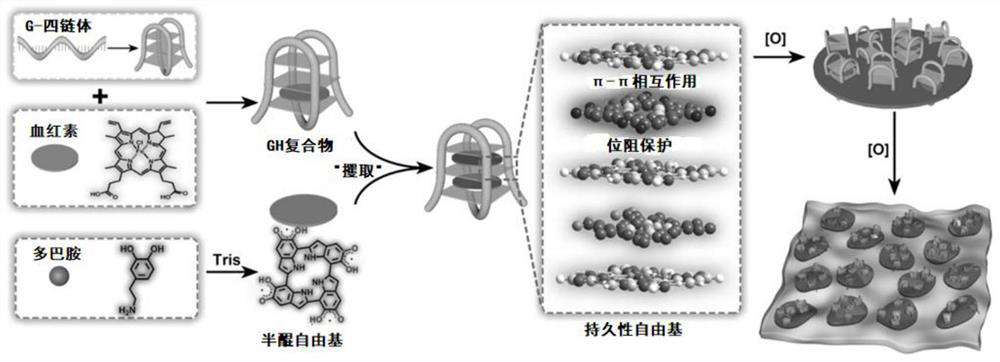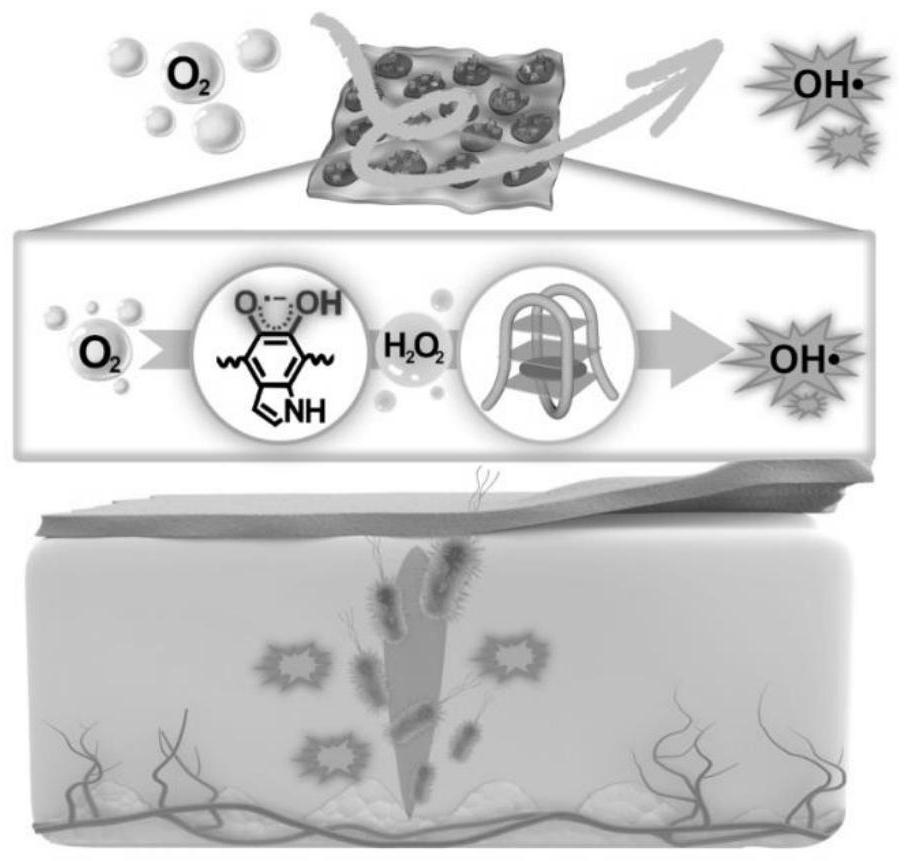Novel semi-quinone free radical nanometer material and preparation method and application thereof
A technology of nanomaterials and free radicals, applied in biochemical equipment and methods, pharmaceutical formulations, genetic engineering, etc., can solve problems such as difficult application and complex preparation of free radicals, and achieve simple and feasible methods, eliminating purification steps and maintenance costs low effect
- Summary
- Abstract
- Description
- Claims
- Application Information
AI Technical Summary
Problems solved by technology
Method used
Image
Examples
Embodiment 1
[0043] Novel semiquinone radical nanomaterials with persistent radical and peroxidase activity
[0044] The G-quadruplex is a special nucleic acid secondary structure formed by the folding of DNA or RNA containing continuous G sequences under specific conditions. Its four G bases are connected by Hoogsteen hydrogen bonds to form a G-tetrad planar structure, and then adjacent G-tetrads form four stable G-quadruplexes through π-π stacking. Heme can be loaded into the G-tetrad interlayer space via π-π stacking to form a DNase with peroxidase activity.
[0045] During the oxidation process of dopamine, it will generate semiquinone free radical intermediates, unpaired electrons in the outermost electron orbit of free radical electrons, resulting in short life and instability. The G-tetrad containing the planar nitrogen heterocycle of guanosine can act as the π electron acceptor, and the oligomer containing the semiquinone free radical acts as the π electron donor, and the two can ...
Embodiment 2
[0048] Preparation
[0049] 1) Annealing and renaturation of nucleic acid containing continuous G sequence to obtain an aqueous solution containing G-quadruplex, adding heme to the aqueous solution and incubating at room temperature for 20-40min to obtain a G4 / Hemin complex, the G-quadruplex The molar ratio of the body to the hemoglobin is 1:1 to 1:200;
[0050] 2) Stir and mix the G4 / Hemin complex and dopamine aqueous solution, and use Tris to adjust the pH to 7-10, and the mass ratio of the G-quadruplex to the dopamine is 0.01:1-2:1;
[0051] 3) The mixture obtained in step 2) is further stirred and centrifuged to obtain the semiquinone radical nanomaterial; the stirring time is 10-30 hours; the centrifugal speed is 5000-20000.
[0052] Morphological characterization (TEM, AFM) of the nanomaterials, such as image 3 , Figure 4 As shown, the size is 1-30 μm, and the thickness is about 15 nm. The composite nanosheets were analyzed by ESR, and the spectra are as attached ...
Embodiment 3
[0054] Efficacy verification
[0055] Since the semiquinone free radical nanomaterials prepared by the present invention can generate ·OH by using oxygen, the nanosheets are dispersed in water containing oxygen for a period of time, centrifuged and detected ·OH in the supernatant aqueous solution. Using TEMPO as a free radical scavenger, the spectrum of ESR analysis is as follows Image 6 , indicating that the composite nanosheets can utilize oxygen in water to generate OH. In addition, terephthalic acid, a specific fluorescent probe for ·OH, was used to detect the amount of ·OH produced by nanosheets with different concentrations. The result is as Figure 7 As shown, as the concentration of semiquinone radical nanosheets increases, the fluorescence intensity increases. In addition, if Figure 8 As shown, the ability of the nanosheets synthesized for different days to produce OH gradually decreased, and 50% efficiency was still maintained after 60 days, indicating that the...
PUM
| Property | Measurement | Unit |
|---|---|---|
| size | aaaaa | aaaaa |
| thickness | aaaaa | aaaaa |
Abstract
Description
Claims
Application Information
 Login to View More
Login to View More - R&D Engineer
- R&D Manager
- IP Professional
- Industry Leading Data Capabilities
- Powerful AI technology
- Patent DNA Extraction
Browse by: Latest US Patents, China's latest patents, Technical Efficacy Thesaurus, Application Domain, Technology Topic, Popular Technical Reports.
© 2024 PatSnap. All rights reserved.Legal|Privacy policy|Modern Slavery Act Transparency Statement|Sitemap|About US| Contact US: help@patsnap.com










